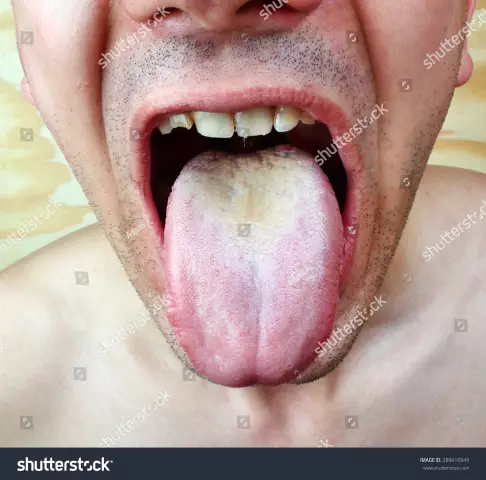- Author Rachel Wainwright [email protected].
- Public 2023-12-15 07:39.
- Last modified 2025-11-02 20:14.
Cracked tongue
The content of the article:
- Causes of cracks in the tongue
- Forms
- Signs
- Diagnostics
- Treatment of cracks in the tongue
- Prevention
- Consequences and complications
Cracks in the tongue are a sign that may indicate the presence of a number of pathologies in the body. There is no exact statistics, however, according to available data, about a quarter of all painful sensations in the oral cavity are caused precisely by cracks in the tongue. It can also be a variant of the structure of the language.
This symptom can occur at any age, but is more often observed in two age categories - in children and in adults over 40 years old.

Cracks in the tongue are a symptom of some pathology in the body
Causes of cracks in the tongue
There are many reasons for the appearance of cracks in the tongue, they can be both local, caused by direct damage to the tongue, and general, caused by any disease of the internal organs:
- hereditary predisposition;
- poor quality prosthetics;
- improper bite, causing injury to the tongue with teeth;
- inflammatory processes in the oral cavity;
- traumatic injuries, burns of the oral cavity;
- diseases of the gastrointestinal tract;
- metabolic disorders;
- allergic reactions;
- autoimmune diseases;
- poisoning with salts of heavy metals;
- dysfunctions of the central nervous system;
- stressful influences;
- diseases of the hematopoietic system;
- Iron-deficiency anemia;
- infectious processes, including helminthic invasions, syphilis;
- avitaminosis;
- immunodeficiency states.
The causes of cracks in the tongue are often several factors at the same time, for example, trauma to the tongue with a poorly fitted filling or prosthesis against the background of latent or diagnosed diabetes mellitus.

Cracks in the tongue may appear due to vitamin deficiency
Often, pathology appears in women during pregnancy. In this case, the occurrence of cracks in the tongue, as a rule, is due to the following conditions:
- vitamin deficiency (hypovitaminosis);
- anemia;
- disorders of the gastrointestinal tract (including those caused by pressure on the internal organs of the growing uterus);
- hormonal changes.
The appearance of cracks in the tongue in children under one year old (in the event that we are not talking about a congenital form) is often provoked by teething, and in adolescence - by hormonal changes in the body.
Forms
Cracks in the tongue can be either congenital (hereditary) or acquired.
Depending on the depth and localization, cracks in the tongue are divided into the following forms:
- folded - as a rule, it is congenital (hereditary), refers to anomalies in the structure of the tongue, unpleasant sensations and does not cause any other problems and does not need treatment;
- diamond-shaped - occurs against the background of diseases of the gastrointestinal tract, is distinguished by a recurrent course;
- desquamative (geographic, "geographic tongue syndrome") - is caused by helminthic invasions, viral infections, hormonal disorders, etc.
Signs
Cracks in the tongue can be of different sizes and localization, depending on the origin and form of pathology.
Folded cracks are observed in a child from birth or at a very early age. Cracks have different depths, lengths and locations, do not change over time, do not cause any painful or other unpleasant sensations. May be accompanied by a white, yellowish or other tinge on the tongue.
With a median (rhomboid) shape, a crack is observed in the middle part of the tongue. In this case, the damaged area has a cyanotic hue. The crack can disappear and reappear, which indicates the chronic course of the disease that caused it. With a diamond shape, patients complain of a painful reaction of the tongue when eating acidic foods. Patients may feel some discomfort due to the accumulation of food debris in a deep crack, followed by its decomposition, which is fraught with the risk of developing inflammation and is accompanied by the appearance of bad breath (halitosis).
In the desquamative form on the surface of the tongue, there are areas of desquamated epithelium that have a bright red color and clear boundaries. At the same time, the cracks are shallow, in some cases they are not at all visible to the naked eye (in contrast to the desquamation areas, which attract attention). The patient complains of a moderate burning sensation of the tongue, which can be aggravated by the use of irritating (spicy, sour, hot) food.
When inflammation or other complications are attached, cracks in the tongue of all types can swell, be accompanied by hyperemia, the appearance or increase of pain, dryness of the oral mucosa, sensation of an enlarged tongue (due to inflammatory edema).
Diagnostics
Diagnostics is not difficult - cracks in the tongue are detected by examination, but since this is not an independent pathology (with the exception of a hereditary form), but only a symptom, the examination is aimed at identifying the cause of the appearance of cracks. For this purpose, carry out:
- a general blood test (helps to assess the general condition of the patient, his immune system, determine the presence of inflammatory processes, anemia, etc.);
- biochemical blood test (carried out to assess the state of the liver, kidneys, metabolism, and also helps to identify autoimmune disorders);
- blood test for HIV;
- research for TORCH infection;
- testing for syphilis;
- coprogram;
- bacteriological examination of scrapings from the surface of the tongue (allows you to identify the causative agent of the infection);
- histological examination (the presence of structural changes in cells and tissues is revealed).

A blood test allows you to identify the reason why cracks appear in the tongue
Differential diagnosis is required with secondary syphilis, glossitis, lichen planus, flat leukoplakia, systemic scleroderma.
Treatment of cracks in the tongue
The choice of tactics for treating cracks in the tongue depends on the reasons that caused their appearance.
Congenital (folded) form of therapy does not require. Also, special treatment of cracks in the tongue of other forms is not required in the absence of discomfort in the tongue and other disturbing symptoms. In this case, treatment consists of treating the underlying disease.
Treatment of cracks in the tongue is carried out if they are accompanied by pain or other discomfort, inflammation. Therapy consists of systemic (general) and local (directly on the tongue) impact.
Systemic exposure involves the treatment of the underlying disease, against which cracks have developed in the tongue, as well as the normalization of impaired body functions. First of all, the oral cavity is improved (fitting or replacing fillings and prostheses, removing tartar, dental treatment). In the case of disorders of the nervous system, sedatives are prescribed. For allergic reactions, antihistamines are indicated. With severe pain, analgesics are prescribed. Attention! Self-medication with the use of analgesic drugs is dangerous by the development of a strong allergic reaction. In addition, patients may be prescribed vitamin complexes, drugs that improve capillary blood circulation, have a biostimulating effect, normalize intestinal functions and the digestive process, etc.
A diet is recommended that is complete in terms of the composition of micro- and macronutrients, but excludes from the diet foods that can irritate the tongue and oral mucosa.

With cracks in the tongue, foods that can have an irritating effect are excluded from the diet
If cracks appear in the tongue against the background of an infectious process, rinsing the mouth with antiseptic and anti-inflammatory solutions is indicated. With desquamative cracks, local application of keratoplastic preparations, fish oil, rosehip and sea buckthorn oil, etc. is shown. A good anti-inflammatory effect in this case is provided by phytotherapy, rinsing and applications with a decoction of lovage herb, chamomile, oak bark are shown.
Physiotherapy is effective: phonophoresis with analgin solution, electrophoresis, iontophoresis, galvanization.
Surgical treatment of cracks in the tongue is carried out with the development of complications - an abscess of the tongue and / or oral cavity, as well as an acute inflammatory process against the background of deep damage to the tissues of the tongue.
Prevention
In order to prevent cracks in the tongue, the following measures are recommended:
- timely treatment of diseases of internal organs;
- compliance with hygiene rules, especially oral hygiene;
- regular preventive examinations at the dentist, elimination of existing dental pathologies;
- prevention of sexually transmitted diseases;
- rational balanced nutrition;
- rejection of bad habits;
- strengthening immunity;
- refusal of self-medication with medications.
To prevent the appearance of cracks in the tongue during pregnancy, it is recommended to regularly monitor the condition of the pregnant woman, as well as to prevent the development of vitamin deficiency and anemia.
Consequences and complications
In the absence of timely adequate treatment, the pathological process can spread to the mucous membrane of the oral cavity, gums, tonsils. The occurrence of abscesses is possible, which, due to the anatomical location, are life-threatening. The likelihood of malignant degeneration of cells in damaged areas of the tongue is minimal, however, with long-term pathology, accompanied by inflammation, it cannot be completely excluded.
YouTube video related to the article:

Anna Aksenova Medical journalist About the author
Education: 2004-2007 "First Kiev Medical College" specialty "Laboratory Diagnostics".
The information is generalized and provided for informational purposes only. At the first sign of illness, see your doctor. Self-medication is hazardous to health!






